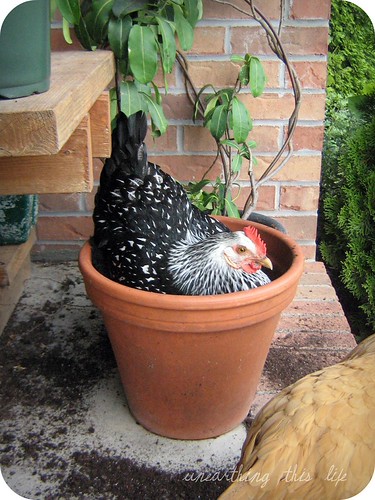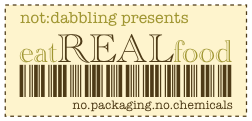 The term “Real Food” definitely applies to the vegetable garden, but here at Tanglewood Farm I’m using this year to try to find ways to grow and preserve more than just our own veggies and fruits. I know this month is our month of gardening posts, however at the core of it, we’re really blogging about growing food. This spring we are growing food in the garden as well as in the farmyard. We’re growing vegetables, fruits, eggs, milk, and yes… even meat.
The term “Real Food” definitely applies to the vegetable garden, but here at Tanglewood Farm I’m using this year to try to find ways to grow and preserve more than just our own veggies and fruits. I know this month is our month of gardening posts, however at the core of it, we’re really blogging about growing food. This spring we are growing food in the garden as well as in the farmyard. We’re growing vegetables, fruits, eggs, milk, and yes… even meat.
When eating any food, I find that the more involved in its existence and its presence on my plate, the better I eat and the more satisfied I am. I love to feel the dirt slowly giving way as I pull a beet for my salad, almost like the void beneath is sucking it down like a vacuum, or the sharp recoiling spring of the cane as I pluck an almost-ripe red raspberry. These experiences are so starkly different from being handed a slapped-together cookie-cutter meal at the local such-and-such chain restaurant. Ick.
I love to sit down to a meal and to be able to identify the work that went into everything: the hauling of compost, the dibble of seeds, the spreading of mulch, the work of the rain and the sun itself… all the way to the act of cooking and baking the food in the kitchen. It’s the most satisfying feeling I can think of. It goes right to my core and radiates from within: Satisfaction. Complacency. Happiness.
To prepare for the season of growing, we have our seeds and our bareroot plants (100% heirloom/open pollinated this year). We also ordered heritage white-laced-red Cornish chicks (WLR because they’re prettier, Cornish because they’re meatier), as well as a couple straight-run layer chicks (heritage Buckeyes and Welsummers). Should any of the layer chicks be cockerels, they’ll be sent to freezer camp once they reach full weight. We want to have a small laying flock that can provide us with eggs, as well as the unfortunate bit of meat here and there.
We’re also growing/raising sheep this year. Unfortunately sheep are not as easy to raise as chickens are, and earlier this week tragedy struck when our youngest ewe, Gertrude, went into early labor and delivered a premature lamb, stillborn. It was very sad, but also humbling and grounding. Gertrude is alive and well, and when it came down to it, it was easy for me to see that her health is all that really matters to me. Should our remaining pregnant ewe, Ingrid, give birth to any rams, depending on conformation, they will likely be raised to mature market weight and then also sent to freezer camp. If they’re ewe lambs, I’ll do a little jig for joy and they’ll either be kept for future breeding or sold as fiber ladies. (I’m noticing a very intense polarizing trend in the preferred gender among various species in the farmyard.)

In the meantime, while either growing or raising our lamb(s), we are hoping to get a bit of milk from Ingrid. She’s not the world’s heaviest milking Icelandic, but she does have a well developed udder so I’ll be trying to take a little off the top once the lambs are established as healthy and strong. Icelandics make a wonderful triple purpose sheep, having lustrous and strong double coated wool, rich creamy milk, and excellent bone structure and meat quality. They’re one of a very few breeds that are triple purpose, so we’re glad to have them. The sheep milk, however, certainly won’t be enough for our milky adventures this year.
I n addition to the sheep, I have purchased a share of a goat (named Gen) at a local goat dairy. I got to meet Gen today, as well as the rest of the goats out at Silver Moon, and it was a great experience for me. If you aren’t familiar with livestock “shares” they’re an interesting method of selling livestock. Basically it comes down to me getting to own Gen for a portion of the week. Whilst owning her, I have access to her for snuggles, kisses, photo ops and, yes, milk. I met her primary owner, Renea, today and she was very pleasant and kindly showed me all around their farm, introducing me to their wonderful fiber rabbits, meat rabbits, quail, muscovies, chickens, and even their horses.
n addition to the sheep, I have purchased a share of a goat (named Gen) at a local goat dairy. I got to meet Gen today, as well as the rest of the goats out at Silver Moon, and it was a great experience for me. If you aren’t familiar with livestock “shares” they’re an interesting method of selling livestock. Basically it comes down to me getting to own Gen for a portion of the week. Whilst owning her, I have access to her for snuggles, kisses, photo ops and, yes, milk. I met her primary owner, Renea, today and she was very pleasant and kindly showed me all around their farm, introducing me to their wonderful fiber rabbits, meat rabbits, quail, muscovies, chickens, and even their horses.
I can’t wait to make goat cheese and sheep cheese and yogurt… or omelettes, and egg salad, and mayonnaise… or smoked sausages, or lamb bacon, or …
You get the idea. This spring is about learning for us, and I can’t stress enough how important it is to be involved in your food. It doesn’t mean going out and slaughtering animals yourself persay, (at least not unless you’re comfortable with it) but you could start by asking the waiter at a restaurant where your beef comes from, or if they’ve looked into local options to take the place of their imported meats…
You could ask around for a local farmers market for animal shares, be they dairy or meat, or just cuddles shares… Take control of what you’re eating, and learn to sit back and take a deep breath, a big bite, and enjoy.
Read Full Post »



































